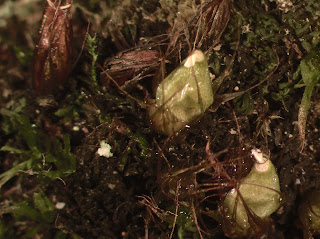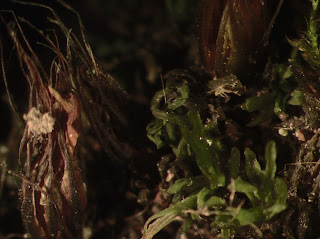 |
| Figure 1. Volvox
Name: Volvox
Common name: Globe algae
Family: Volvoacaceae
Collection date: November 15, 2015
Location: Hiram, OH
Description: Chlorophyte green algae with 2 flagella
Key used: "Identification of Algae in water samples"
Keying steps:
1b) 2b) 3a) 40b) 41b) 49b) 80b) 51a)...Volvox Links: http://micro.magnet.fsu.edu/optics/olympusmicd/galleries/brightfield/volvox.html http://www.microscopy-uk.org.uk/index.html?http://www.microscopy-uk.org.uk/mag/art97b/volvoxms.html |
Tuesday, November 17, 2015
Specimen #20 Volvox
Monday, November 16, 2015
Specimen #19 Stereum striatum
Specimen #18 Wood Ear Fungus
Specimen #17 Comb Fungus
 |
| Figure 1. Hermicium ramosum on rotting wood |
 |
| Figure 2. Close up above view |
Specimen #16 Wolf's Milk
 |
| Figure 1. Lycogala epiderdrum
Name: Lycogala epiderdrum
Common name: Wolf's Milk
Family: Tubiferaceae
Collection date: September 18, 2015
Habitat: Log
Location: Hiram, OH
Description: Round brown, or pink, sac-like structure alone or in groups
Key used: Keller, Harold W. and Brown, Karl L.(1799). Myxomycetes of Ohio: Their systematics, biology, and use in teaching. Ohio Biological Survey.
Keying steps:
1b) Fruiting bodies not as above; spores occurring in a mass within fruiting body and enclosed (at least during the early stages of development) by a perineum
2a) True capillitium absent, pseduocapillitium composed of irregular elements sometimes present...Order Liceales
1a) Fruiting body an aethalium or pseudoaethalium
2a) Pseudocarpillitum present and usually rather evident, but not taking the form of a columella-like structure
3a) Fruiting body an aethalium, pulvinate to subglobose, with no evidence of individual sporangium-like units
4a) Pseudocapillitium consisting of flattened hyaline tubules; spores pallid...Lycogala epidendrum
Links:
|
Tuesday, November 10, 2015
Specimen #15 Metatrichia vesparium
 |
| Figure 1. spore cases |
 |
| Figure 2. Metatrichia vesparium found on a dead log |
Specimen #14 Cladonia foliacea
 |
| Figure 1. Close up of the squamulose lichen |
Keying steps:
Key G. Squamulose Lichens pg. 134
1. Thallus dull or shiny, but not gelatinous when wet
3. Thallus pale green, gray, brown, olive, or black without yellowish or orange tint
17. Squamules ascending or erect, flat or cylindrical, with the lower surface easily seen
18. Thallus composed of flat, clearly dorsiventral squabbles
20. Squamules not more than 3 times longer than broad, apothecia occurring singly, thallus cortex K-(atranorin absent) relatively common
21. Squamules lobed or finely divided, apothecia raised on a stalk or stipe; thallus cortex C-, KC-(gyrophoric acid absent as main compound)
Links:
Specimen #13 Veilwort
 |
| Figure 1. Leaves of Pallavicinia lyellii |
 |
| Figure 2. Cell close up |
 |
| Figure 3. Costa close up
Name: Pallavicinia lyellii
Common name: Veilwort
Family: Pallaviciniaceae
Collection date: September 14, 2015
Habitat: Dead log
Location: Hiram, OH
Description: "Thalli prostate in thin patches, pale green, thalli 2-6cm long and 4-5cm wide with a central strand. On wet banks along streams and in swamps, Minnesota to Newfoundland South to Florida, Alabama, Mississippi, and Luisiana."
Key used: Concard, H.S.(1956). How to Know the Mosses and Liverworts. WMC. Brown Company.
Keying steps:
1b) Plants Thalloid or, if with stems and leaves, the larger leaves in two rows on the stem and a third row of leaves often present on the underside of the stem, never on the upper side. Rhizoids unicellular, sporophyte short lived.
4b) Plants thalloid or leafy with more than one chloroplast per cell
5a) Plant strongly flattened, thalloid, without distinction between stem and leaf.
6a) Plants with a translucent or transparent thallus, internal tissue homogenous; rhizoids all smooth on internal wall; sporophyte with capsule dividing regularly into 4 valves or dehiscing irregularly and retained in a scam-like structure 7b) Thalli ribbon-shapped, not covered on upper surface with pear-shaped sacs; capsules regularly splitting into four lobes, elater present..pg. 238 Metzgeriales Metzgeriales 1b) Plants thallouse of shallowly lobed 2b) Margins of thallus wavy or even, but not shallowly lobed 3a) Midrib wel defined, bulging like a cord along lower side of plant, rest of thallus only 1 cell thick 4b) Plant 3-4mm wide, often irregularly wavy; sex organs on oppressed along midrib 5a) midrib with a central strand of small, thick-walled cells. Links: http://www.bbsfieldguide.org.uk/sites/default/files/pdfs/liverworts/Pallavicinia_lyellii.pdf http://hiddenforest.co.nz/bryophytes/liverworts/leafy/pallaviciniaceae/palla01.htm |
Specimen #12 Powder Gun Moss
 |
| Figure 1. Spore pods |
Specimen #11 Snakewort
 |
| Figure 1. Conocephalum concur found on a rock next to a river |
 |
| Figure 2. Chloroplast close up |
Subscribe to:
Comments (Atom)






